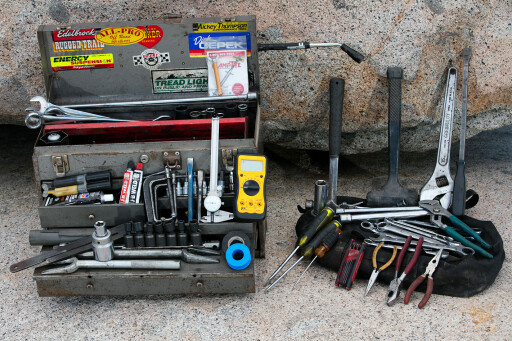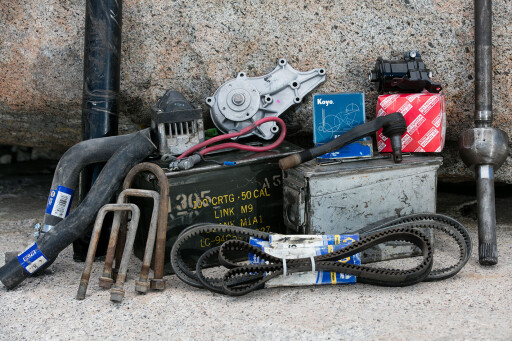
Drawing from 35 years of experience of 4x4 adventures, Chris Collard outlines his list of items that are necessary for any self-supported travel.
In the second instalment of this series we cover essential tools and items need to carry out basic repair and maintenance to keep your 4x4 running no matter where you are. Read Part 1 for Chris' advice and tips on basic essentials for travelling in the countryside and recovering your 4x4.
Tools (basic) Suitcase
While pre-packaged toolkits are handy and the plastic cases have a place for every socket and screwdriver, they are far from adequate and occupy too much real estate for the limited assets they carry.
I carry two kits. The first is a heavy canvas bag stuffed with the basics: 1/2- and 3/8-inch sockets, metric and ASE spanners, Vise-Grips, Channellocks, needle-nose pliers, screwdrivers and such. I call this my I-don’t-want-to-retrieve-my-toolbox bag, and store it behind the driver’s seat. My main toolbox, which is buried behind loads of other gear, is a shop-grade, multi-drawer unit. It contains the seldom-needed items such as a multimeter, JB Weld, Teflon and electrical tape, pickle forks, files and punches, along with various small items.
 A telescopic magnet and emery cloth are good examples of little implements that can have a big impact. If you need to polish a bearing surface or extract an air cleaner nut from the depths of a carburetor, they are the only tools for the job.
A telescopic magnet and emery cloth are good examples of little implements that can have a big impact. If you need to polish a bearing surface or extract an air cleaner nut from the depths of a carburetor, they are the only tools for the job.
Takeaway: toss the plastic organiser in lieu of a handy canvas bag and proper toolbox.
Basic Tools Suitcase Arrangement
A spare part won’t do you any good if you don’t have the appropriate tools to install it. My tools are separated into two categories. Basic tools are stowed in a handy location (canvas bag on right), while seldom-used items stay in my main toolbox.
Chris' Basic Tool Tips:
1 - Store a basic toolkit in a handy location
2 - Seldom-used items reside in your main toolbox
3 - Small items can be a big asset.
Chris' Basic Tools Suitcase Item List:
- Metric and SAE spanners
- Metric and SAE sockets (¼, ½, ¾ inch)
- Screwdriver set
- Allen set
- Channellocks (large, small)
- Crescent wrenches (large, small)
- Vise-Grips (large, small, needle-nose)
- Files (combination, keyhole)
- Hacksaw
- Dead-blow mallet, hammer
- Hub wrench
- Pinion nut socket
- Pickle fork (two sizes)
- Pry bar
- Snap-ring pliers
- C-clamps (small)
- Brake line bender
- Multimeter
- Telescopic magnet
- Gasket material
- Wire kit, wire, crimper
- Fuses
- Brass punch, metal chisel/punch
- Tape (Teflon, electrical)
- Cleaning brush
- Spark plug thread bore
- Emery cloth
- Dental tools (picks, tweezers)
- Alligator-clip jumpers
- JB Weld, Loctite, fuel cell epoxy
- Stop leak
- Utility knife
Fluids Suitcase
Fluids are also items that cross all vehicle makes, and a full selection should be carried at all times.
 In the mid-1980s, I was on the Rubicon Trail stuck behind a group with a broken vehicle (bad power steering pump). They would not allow us to get around on a bypass (one of them actually said, “you %#&@ Toyotas can go back to the &%#@ highway where you belong). After we waited patiently, the knucklehead walked back and asked if we had any power steering fluid they could have. I sarcastically said, “Of course, don’t all prepared four-wheelers carry the basics... yours is back at the highway.”
In the mid-1980s, I was on the Rubicon Trail stuck behind a group with a broken vehicle (bad power steering pump). They would not allow us to get around on a bypass (one of them actually said, “you %#&@ Toyotas can go back to the &%#@ highway where you belong). After we waited patiently, the knucklehead walked back and asked if we had any power steering fluid they could have. I sarcastically said, “Of course, don’t all prepared four-wheelers carry the basics... yours is back at the highway.”
I handed over a quart to get them out of our way.
Takeaway: don’t be a knucklehead.
Fluids Suitcase Essentials List:
Every vehicle should carry basic fluids: brake cleaner, power steering and brake fluid, engine and differential oil, WD-40, starting fluid, bearing grease, shop towels, and hand cleaner. Store them in a leak-proof container, as they will eventually leak.
Chris' Fluids Tips:
1 - Standard fluids will work on any vehicle (temporarily).
2 - If each vehicle carries an array of fluids, you will have enough for any job.
3 - Bring a drain pan and container to store used fluids.
Chris' Fluids Suitcase Item List:
- Motor oil (2 quarts)
- Diff/transmission oil (2 quarts)
- Oil pump
- Power steering and brake fluid
- Brake cleaner
- Carb/mass air-sensor cleaner
- Drain pan, kitty litter
- Used oil container
- Bearing grease (high temp)
- Siphon hose (shaker type)
- Starting fluid
- WD-40
- Hand cleaner
Spare Parts Suitcase
What spare parts to bring has been the topic of many campfire debates. If you drive a late-model vehicle, the list may be limited to belts, hoses and filters. If your love is an old Willys MB or Toyota FJ-40, I suggest you become intimately familiar with its nuances. Read enthusiast forums and query other owners for info on common mechanical issues and what items to carry. The spares kit in my 1982 Hilux (a rock rig) includes axles, drivelines, steering components, a cap, rotor, and an igniter (the list goes on). However, my 2002 Tacoma’s inventory is limited to belts, hoses, water pump and a few small parts. I carry extra wheel bearings in the Hilux (a field fix), but changing a Tacoma bearing isn’t possible without a press and jig.
 Design the spares kit around your vehicle, type of travel and distance from services. There is one caveat: if you carry a part, even if the repair cannot done in the field or you lack the mechanical skills to perform the job, it will expedite the process when you get to a shop.
Design the spares kit around your vehicle, type of travel and distance from services. There is one caveat: if you carry a part, even if the repair cannot done in the field or you lack the mechanical skills to perform the job, it will expedite the process when you get to a shop.
One interesting scenario I’ve dealt with was when the clutch throw-out bearing on a friend’s vehicle flew the coop. Steve, the world’s greatest pack rat, had a used one in his parts box. We set up camp, dropped the transmission, swapped in the used (but functional) bearing and, voilà, were able to continue on in the morning. Takeaway: if you have room for a spare part, it is better to have it than partake in a forced march in the desert.
Spare Parts Suitcase kit List:
Spares should be specific to your vehicle. This kit includes a driveline, front axle shaft, rod end, U-bolts, fuel filter, wheel bearings/seals, water pump, hoses, belts, battery cable, and igniter. The ammo cans hold everything from clutch and brake hydraulic kits to lug nuts.
Chris' Spare Parts Tips:
1 - Research your vehicle for potential weak links.
2 - Spares that cannot be swapped in the field are usually low priority.
3 - Include small “used” parts from previous upgrades.
Chris' Spare Parts Suitcase List:
- Battery cables
- Belts
- Axles and seals
- Brake line
- Clutch and brake slave cylinder kit
- Fuel pump, line, clamps, filter
- Drivelines
- Distributor cap, rotor, coil, points
- Leaf/coil spring
- Radiator hoses and clamps
- Steering (tie rod, links, ends)
- U-bolts and nuts
- U-joints
- Water hose (various diameters, 3 feet)
- Water pump
- Wheel bearings and seals
- Thermostat

COMMENTS